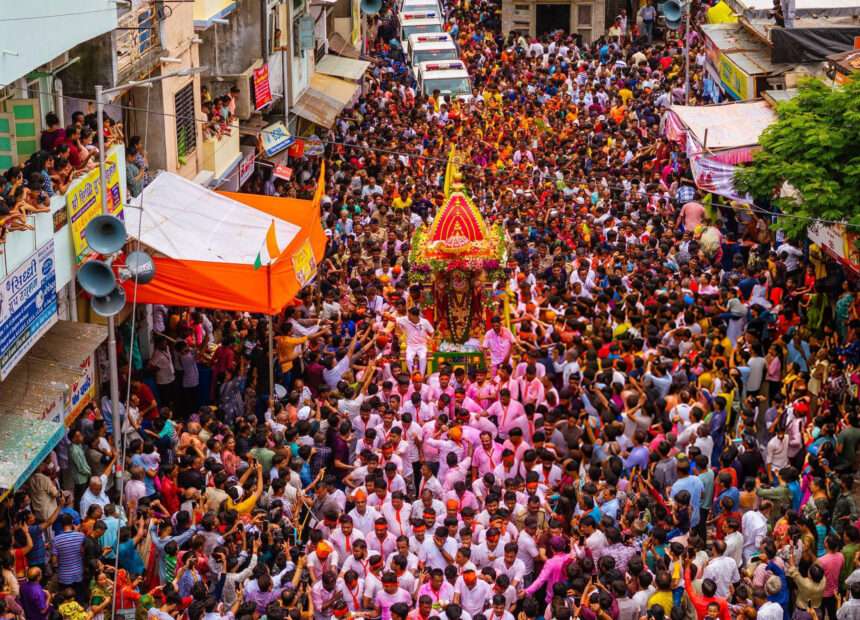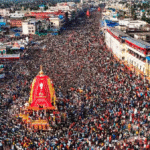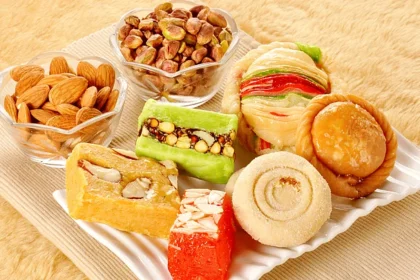Every year, the sacred city of Puri in Odisha transforms into a living ocean of devotion, color, chants, and spiritual fervor. Millions of pilgrims and tourists come together to witness one of the world’s most visually spectacular and soul-touching events – the Jagannath Rath Yatra. Also known as the Festival of Chariots, this age-old tradition blends mythology, spirituality, culture, and community into a massive celebration of divine presence on Earth.

What is Jagannath Rath Yatra?
The Jagannath Rath Yatra is a grand Hindu procession where the deities Lord Jagannath (a form of Krishna), his elder brother Balabhadra, and sister Subhadra are placed on gigantic wooden chariots and pulled through the streets of Puri. The term “Rath Yatra” literally means “Chariot Journey,” and it symbolizes the movement of the divine out of the temple sanctum to bless devotees of all backgrounds, including those who may not traditionally be allowed inside the temple.
Mythological Origins and Deep Symbolism
The origins of this sacred event trace back to ancient times and are deeply rooted in Hindu mythology. It is believed that once a year, Lord Jagannath expresses his wish to visit his birthplace, the Gundicha Temple.The Lord’s love for his followers and his wish to bring the masses together outside the temple walls are symbolized by this visit. The Rath Yatra reflects Lord Jagannath’s inclusiveness and humility.
It’s the only time in the year when these deities leave the temple, making it possible for people from all walks of life – regardless of caste, religion, or gender – to have darshan (sacred viewing). This gesture makes the festival an epitome of spiritual democracy and universal acceptance.
The Three Magnificent Chariots
Each of the three deities rides in a separate chariot, uniquely crafted with detailed woodwork and vibrant canopies made with thousands of meters of fabric:
- Nandighosha – Lord Jagannath’s chariot has 16 wheels and is the tallest, standing at approximately 45 feet.
- Taladhwaja – The chariot for Balabhadra has 14 wheels and is slightly shorter than Nandighosha.
- Darpadalana – The chariot for Subhadra has 12 wheels and is distinct with red and black canopies.

These massive structures are built afresh every year using sacred neem wood by a special group of artisans known as Maharana and Bhoi servitors, following centuries-old traditional techniques. The construction begins months in advance and is considered a spiritual duty passed down through generations.
Key Rituals That Enrich the Yatra
Several age-old traditions mark the Jagannath Rath Yatra:
- Pahandi Bije: In the midst of drumbeats, chanting, and an exhilarating spirit of devotion, the deities are ceremoniously brought from the shrine to the chariots.
- Chhera Pahanra: The Gajapati King of Puri sweeps the platform of each chariot with a golden broom. This act of humility reinforces the idea that all are equal before the Lord.
- Devotees Pull the Ropes: The Yatra’s high point is when the devotees, frequently barefoot, pull the enormous chariots while yelling “Jai Jagannath.” Pulling the chariot ropes is thought to bring favors from God.
The Route and Schedule
The Rath Yatra starts at the Jagannath Temple and travels roughly three kilometers to the Gundicha Temple via Bada Danda (Grand Road). The Bahuda Yatra, or return trek, begins after the nine-day stay of the deities.
Key dates for 2025:
- Rath Yatra: 29th June 2025
- Hera Panchami: 3rd July 2025 (symbolic displeasure of Goddess Lakshmi)
- Bahuda Yatra: 7th July 2025
- Suna Besha: 8th July 2025 (deities adorned in gold ornaments)
Global Celebrations Beyond Puri
The thriving Odia diaspora and organizations like ISKCON have made it possible for the Jagannath Rath Yatra to transcend national boundaries. Today, you’ll find processions held in cities such as London, New York, Paris, Tokyo, and Sydney, attracting thousands of participants from different cultures and faiths.
In each city, wooden replicas of the chariots are built, devotional songs are sung, and food is distributed as prasad. These events help spread awareness of Indian culture and highlight the message of global spiritual unity.
Food: A Spiritual Offering
One of the most significant and unique parts of the festival is Mahaprasad — sacred food offered to the deities and later distributed among devotees. The Jagannath Temple is home to one of the largest open-air kitchens in the world, where over 100 varieties of food are cooked daily.

Some famous dishes include:
- Mahaprasad Thali: Rice, dal, vegetables, sweet dishes, and pickles
- Khaja: A flour and sugar syrup-based crispy layered dessert
- Dalma: Dalma is a dish made of lentils, veggies, and traditional spices
- Chhena Poda: A decadent baked cottage cheese treat
- Rasabali: Fried cheese patties soaked in thickened milk
Eating Mahaprasad is thought to calm the heart and cleanse the soul.
How to Reach Puri
- By Air: Nearest airport is Biju Patnaik International Airport in Bhubaneswar (60 km away)
- By Rail: Direct trains connect Puri with major Indian cities like Delhi, Mumbai, Kolkata, and Chennai
- By Road: Well-connected highways and buses run regularly from Bhubaneswar and other cities
Travel Tips:
- Book accommodations early — hotels, dharamshalas, and guesthouses fill up fast
- Carry light cotton clothing and stay hydrated
- Be respectful of local customs and spiritual sentiments
- If possible, hire a local guide for a deeper cultural experience
Why You Should Experience It At Least Once
The Jagannath Rath Yatra is a profound spiritual experience as well as a cultural extravaganza. It is about joy, surrender, and group celebration. Even if you are not deeply religious, being part of this journey is emotionally stirring. It teaches humility, promotes equality, and ignites a sense of connection with something bigger than oneself.
Whether you are a spiritual seeker, a curious traveler, or a cultural enthusiast, the Jagannath Rath Yatra offers an experience like no other. It’s a festival where tradition moves on wheels, where gods come closer to the people, and where every pull of the chariot rope brings hearts together in faith.










